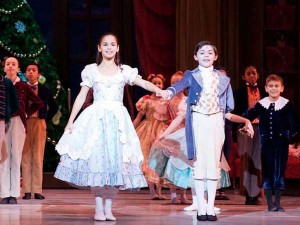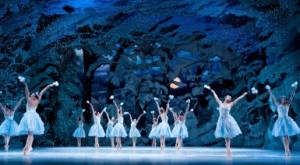Published by The Dance Journal. Published by kind permission.
Some of the nastiest Philly weather so far accompanied last weekend’s evening performance of the Pennsylvania Ballet’s production of George Balanchine’s The Nutcracker at the Academy of Music. But, the wintry mix did not dampen the mood in what looked like a full house of many families, certainly not the excitement of little girls in sparkling theater dresses and lads in smart suits. Or, for that matter their parents, who were excited for them, even those who braced themselves at sitting through a lot of fluff to get to any real dancing.

in George Balanchine’s The Nutcracker. Photo: Alexander Iziliaev
Pennsylvania Ballet is only one of just a few companies licensed to do Balanchine’s 1954 classic. Balanchine, nostalgic over Imperial Ballet imagery, concocts a jewel box ballet that can look privileged and musty by now. Where are the the Russian ‘Trepak’ dance (knee hopping, barrel rolling Cossacks), for instance, that turn up in more folkloric versions. But, Balanchine’s ballet provides a good strength test, especially for a mid-sized company, with rotating casts to cover all the parts for a month of performances. It taps the technical skills of precision and pacing in the strong ensemble sections, for instance and decisively in the finale with the Sugar Plum- Cavalier grand pas de deux.
The other marker is the esprit the company puts into the character dancing that have to keep the kids in the audience enchanted when they are used to hi-def and high tech entertainments. So much of old world, Imperial Ballet Balanchine is set in, however fleetingly, and the dance challenges in many of the scenes are in the refinement, not the dazzle. By now, Pennsylvania Ballet stylizes to keep this less under glass to contemporary audiences in subtle, effective ways. Pennsylvania Ballet’s fuels the gestural acting with smart character touches that enliven all of the pantomime that goes on, for instance.
The tempo of the score for one. Philadelphians who remember how much slower Eugene Ormandy set it for his famous recording, should marvel at how fleet conductor Beatrice Jona Affron‘s pacing that moves a potentially wheezy first act, with Balanchine lingering on pristine those images of Christmas past. An adult crowd pleaser is a chance to hear Luigi Mazzocchi’s masterful violin solo after the party scene, his rich tone just bathing the Academy.
Abbie Rorke plays Marie, with confident acting skill and ballerina deportment. Just as charming is young actor Tino Tino Karakousis, age 7, playing the little brother Fritz at his brattiest, shoving people and scampering around was not only delightful, it is artful dance-dodgery. Aidan Duffy gallantly plays the young man who loves Marie and saves her from the Mouse King. The students from Pennsylvania Ballet school dancing the parlor promenade and the Polichinelles pirate dance with equal aplomb and skill.
Rachel Maher and Edward Barnes and were flawless in their pantomime acting as the holiday party givers. The mysterious Herr Drosselmeier was very magically animated by Lorin Mathis. Alex Peters was not only military sharp in the clockwork movements of the Toy Soldier; he had a tragedy in his eyes that gave it soul. Finally, the full dance scene of The Snowflakes, which never disappoints with only drifty spots in the opening chasses, jetes and group swirls, by the time these ladies had their snow wands and the Philadelphia Boys Choir were serenading, they were in crystalline drill.

The real dancing starts in the second act, overseen by those hydra-foiling little angels. Lillian di Piazza commandeered as The Sugar Plum Fairy. Di Piazza’s studied phrasing didn’t float the adagio work to full lightness, but that is a minor distraction, from her overall magical presence.
On came the divertissements troops, the Chocolates, always too short a dance, with flamenco touches thrown in, danced with flair by lead couple Evelyn Kocak and Amir Yogev. Caralin Curcio just smoked as Coffee, a harem seduction, in her variations of storybook Arabian exoticism. Curcio was more than slinky and sexy, her every detail was polished, capped off with a slow pointe slide to a split, then a supple back bend that just mesmerizes.
The Marzipan Sheperdesses were a bit scrambled in this performance behind lead Sheperdess Rachel Jambois, but all of the musical charm was in place. Later Brooke Moore commandeered The Dewdrops with more precision canon lines that bloom with Balanchine’s showgirl pageantry. Moore moves around and through the ensemble with crisp, air-slicing jetes and solid pointe work. Slight vamping on the piques signal that she was having a ball. Yogev was back as the lead Candy Cane, always a crowd pleaser by virtue of its repetition hoop jumps and Yogev and the back up Canes, nailed it.
The pas de deux of The Sugar Plum Fairy and her Cavalier, in this performance danced by Di Piazza and Jong Suk Park, is by design alternately flowing and jarring, with a lot of pointe freezes and Balanchine limb tangles. They struggled somewhat on the slow turns with Di Piazza en pointe, making slight adjustments and the deep penche arabesque didn‘t tilt enough, but these were momentary snags. Park has an unfussy attack for the jump circles around the stage and Di Piazza has a diamond hard arabesque that just keeps giving. They held a tight gaze on each other, paced the big moments with thrilling results- the jump of Sugar Plum on the Cavalier’s shoulder, then repeated, was first rate and they locked into that iconic Poisson finale pose, to rapturous applause. December 7-29, 2013, paballet.org.
